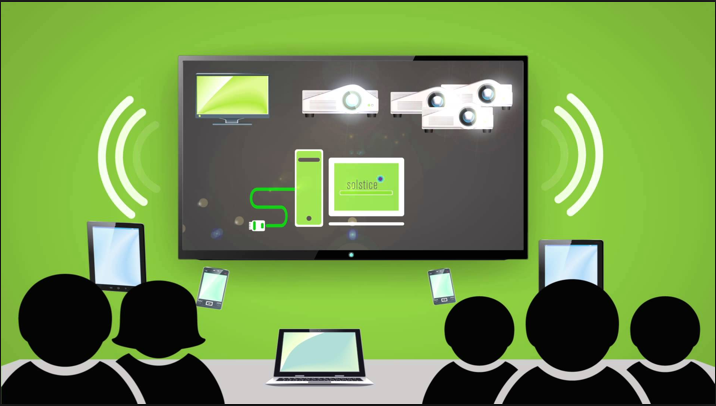Mersive was one of the breakout stars of last year's InfoComm. With Solstice, the company's media sharing/collaboration product, attendees were given a glimpse of what a truly converged world might look like—one without wires, and one that revolves largely around software.
Mersive's Solstice 2.0 is a "customer driven release," according to founder/CTO Chris Jaynes.
- One year later, 'collaboration' has become such a ubiquitous word that I'm almost tired of typing it, and Mersive is making a return to what will surely be a very interesting show. Microsoft (a software company) will be the largest exhibitor on the floor, and more and more companies are playing in the media sharing space than ever before.
- All of these developments have Mersive excited. For founder/CTO Chris Jaynes and CEO Rob Balgley, not only do they validate the prescience of the company's vision, they also perfectly set the stage for the debut of Solstice 2.0, a big update which the duo are sure is going to be a showstopper.
- Jaynes and Balgley have spent the past year evangelizing their product, getting an overview of where this growing market segment is at, and using their discoveries to ascertain where they see it heading. "There's a real challenge in the market to educate higher ed, corporate, and government in how the market is developing," explained Balgley. "Because you've got everything from Chromecast to Apple TV all the way on through to the big AV guys, and then smaller players like ourselves—the market is very turbulent."
- Balgley described coming across all kinds of peculiar behavior in these market segments, like discovering closets full of Apple TVs. "It's been interesting to come into these situations and explain to people that OK, Apple TV is not an enterprise product, it's not going to support your use case. If you're going to scale this within the enterprise, you're going to have to look at the following things."
- It's these customers and the many like them that are behind the Solstice 2.0 release.
- "This is a customer driven release," said Jaynes. "We had Solstice in the market for a little over a year, and the whole year was spent meeting with customers, selling to customers, watching people play with the system, and then listening to their feedback, and it resulted in a new feature set. In a nascent market, that's really important—you don't want to get caught out with a product that's just not going to change. So we would watch users use it and ask three simple questions: What's your favorite part of the product? Does it support or get in the way of meetings? What are you noticing about the UI?"
- As Jaynes described it, the feedback they received resulted in three main themes being implemented in the new release.
- The first is a usability upgrade on all the clients. Solstice is now the only product that gives a "what you see is what you get" interface on the client. "If I go into a room and I look down on my iPad after I've joined a meeting," said Jaynes, "what's on my screen matches whats on the main screen—and those are all intractable elements. I can grab a post that somebody is streaming on their desktop. It's incredibly intuitive but a technical challenge, but we cracked that nut."
- The second is quite possibly the most exciting part of this upgrade—Solstice is now touch enabled. If you're lecturing from the front of a room, teaching a class, or simply presenting, you can now turn to the screen and interact with the elements on it in the same way that you would from your device or computer.
- "Managing the media is the key because the difference between simple screen scraping and what do you do once the media has been presented on the display is a really important differentiator," said Balgley. "In that sense, we think we are leading the market. What everyone else is focused on is getting the content to the display itself. But what we're finding with our customers is that its not enough to put the content on the display—they want to manage it once its there."
- In that same vein, Solstice 2.0 will also add the ability to stack media, and the stacks can be flipped through and treated as a single element. This is all with the goal of allowing the user to manage the media a little better.
- The third main part of the upgrade is built in AirPlay support. Now if you walk into a room and open up your iPad and want to stream an arbitrary application to the screen, you can do that through the AirPlay protocol. "This is totally integrated with Solstice," explained Jaynes. "If I'm a professor and I'm in moderator mode and a student at the back of the room uses AirPlay to try to stream to the screen, it's totally embraced by Solstice for the user experience. So you get a pop-up that alerts the professor, and you can accept or reject his iPad posts and get a live view of his iPad mirroring. It's all kind of pulled into our ecosystem now." This also works on OSX.
- The duo emphasized that as good as they are at describing this stuff, all these changes add up in a way that is hard to understand. "Even seeing it," Balgley said, "is not as good as using it."
- So when you visit Mersive on the show floor, grab one of the mobile devices and use it. Don't just watch someone use it. Use it yourself.
- "It's snappy and slick," concluded Balgley. "The prior product worked really well and did what it needed to and satisfied the functional requirement, but this satisfies the functional requirement in a way that's very pleasing. There's a very different tactile feel to the product, and I think it's going to blow people's minds."










